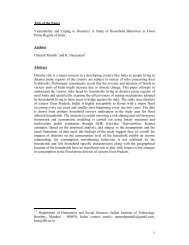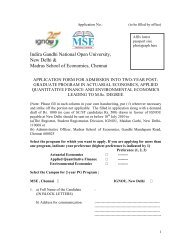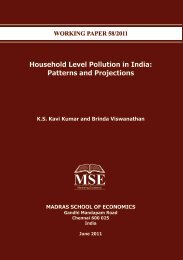A Macro-Fiscal Modeling Framework for Forecasting and Policy ...
A Macro-Fiscal Modeling Framework for Forecasting and Policy ...
A Macro-Fiscal Modeling Framework for Forecasting and Policy ...
You also want an ePaper? Increase the reach of your titles
YUMPU automatically turns print PDFs into web optimized ePapers that Google loves.
2.6 Structural Breaks in Indian <strong>Macro</strong>economic Series: Some Recent Debates<br />
<strong>Macro</strong> model builders in India have generally not taken into account structural breaks in<br />
various time series. However, <strong>for</strong> some important series like growth in real GDP, there<br />
has been a discussion regarding the timing of the structural break. One contention is that<br />
there was a structural break in 1980-81 in the case of India‟s aggregate real GDP. There<br />
are studies that have dated the breakdates differently. Some of the main results in these<br />
studies are highlighted below.<br />
1. DeLong (2001) has argued that the growth rate accelerated from the traditional<br />
„Hindu‟ growth rate during the mid-1980s. He associated with the economic re<strong>for</strong>ms<br />
that took place during Rajiv G<strong>and</strong>hi‟s tenure. This upward break occurred during the<br />
so-called „licence raj‟ while liberalisation of the economy since 1991-92 did not make<br />
a perceptible impact on it.<br />
2. Wallack (2003) finds that <strong>for</strong> GDP growth, 1980 was the most significant date <strong>for</strong><br />
the break <strong>and</strong> <strong>for</strong> GNP the break growth took place in 1987. A significant break in<br />
the trade, transport, storage <strong>and</strong> communication growth rate happened in 1992, but<br />
no break <strong>for</strong> the primary <strong>and</strong> secondary sectors as well as public administration,<br />
defence <strong>and</strong> other services.<br />
3. Rodrick <strong>and</strong> Subramanian (2004) computed, using the procedure described in Bai<br />
<strong>and</strong> Perron (1998, 2003), the optimal one, two, <strong>and</strong> three break points <strong>for</strong> the<br />
growth rate of four series: per capita GDP computed at constant dollars (World<br />
Bank) <strong>and</strong> at PPP prices (PWT), GDP per worker (PWT), <strong>and</strong> total factor productivity<br />
(Bosworth <strong>and</strong> Collins, 2003). In all four cases, they find that the single break<br />
occurs in 1979. Rodrik <strong>and</strong> Subramanian (2004) have argued that the 1980s<br />
phenomenon could be largely attributed to a change in the government‟s attitude<br />
towards business, particularly large incumbents. Their econometric analysis shows a<br />
close correlation between the rates of growth of states governed by the ruling party<br />
or its allies at the centre.<br />
4. Virmani (2004) dates the structural break in 1980-81.<br />
5. Panagariya (2004) has countered, on the other h<strong>and</strong>, that the more systematic<br />
re<strong>for</strong>ms of the 1990s gave rise to more sustainable <strong>and</strong> stable growth. He points to<br />
the large annual fluctuations in growth rates in the 1980s compared to smaller<br />
fluctuations in the 1990s, as evidence in support of his unsustainability argument.<br />
6. Sinha <strong>and</strong> Tejani (2004) argue that the 1980-81 break in growth in India‟s GDP was<br />
due to improvement in labour productivity, propelled by imports of higher quality<br />
machinery <strong>and</strong> capital goods.<br />
33



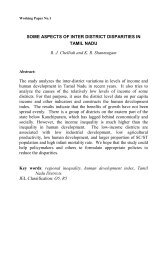

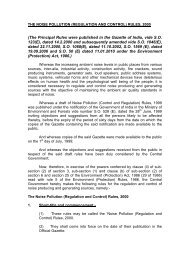
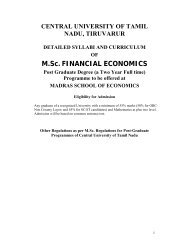
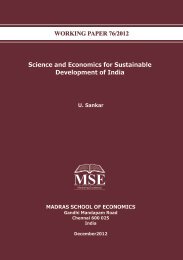
![Curriculum Vitae [pdf] - Madras School of Economics](https://img.yumpu.com/49878970/1/190x245/curriculum-vitae-pdf-madras-school-of-economics.jpg?quality=85)
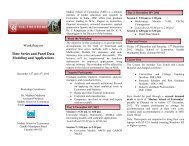
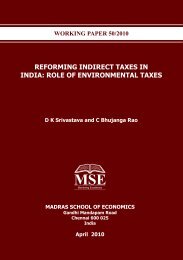
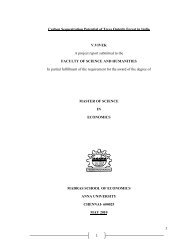
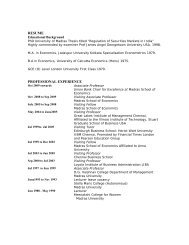
![Curriculum Vitae [pdf] - Madras School of Economics](https://img.yumpu.com/48715201/1/184x260/curriculum-vitae-pdf-madras-school-of-economics.jpg?quality=85)
